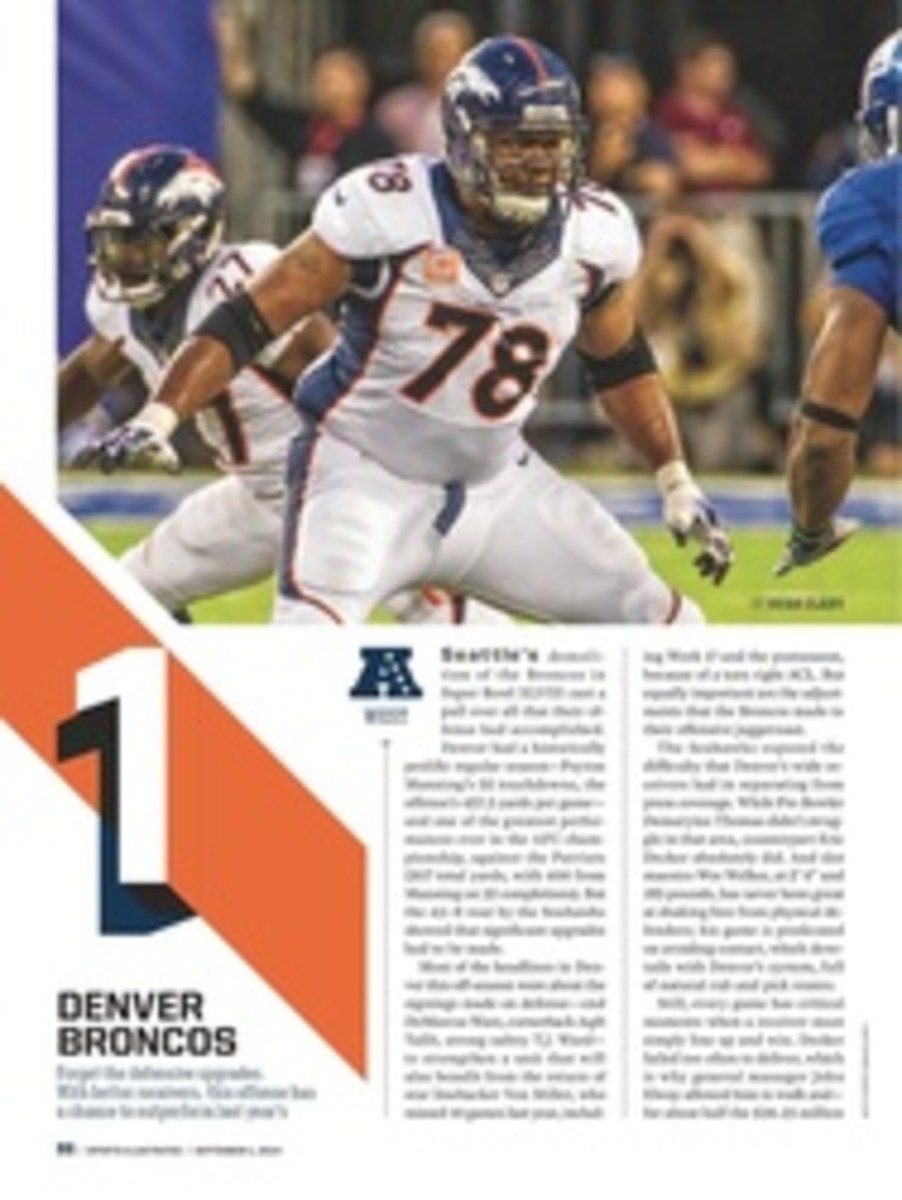
2 PITTSBURGH STEELERS
No team in pro sports is more synonymous with stingy defense than the Steelers. Pittsburgh had the Steel Curtain in the 1970s, the zone-blitzing monsters in the '90s and the kamikaze playmaking Troy Polamalu groups in the 2000s. But lately this defense has drifted into mediocrity. In '12, though ranking first in yards allowed, it was just 25th in turnovers and 15th in sacks. Last season the turnover and sack numbers remained low (they ranked 27th and 25th in those categories), and thanks to unusually shoddy tackling, the Steelers fell to 13th in yards allowed. Most notably, they surrendered 17 plays of 40 yards or more, tied for fifth most in the league. Those big plays—five more than they had given up in the previous three seasons combined—are the leading reason Pittsburgh endured a second straight .500 season.
Creating big plays while not surrendering them has been the signature of longtime coordinator Dick LeBeau. Few think of the Steelers as having a bend-but-don't-break defense, but that's basically what it is—at least on first and second down, when LeBeau mostly stays in straight 3--4 looks and gives a cushion in coverage. With this approach he says to an offense, "You can have all the three-yard runs and five-yard completions you want. But you'll have to mount 12-play drives to score, and we're betting that at some point, you'll make a mistake. When you do, we'll pounce."
It's in third-and-long that LeBeau's zone-blitz packages come out, and this is where the sacks and forced turnovers need to happen. LeBeau's brilliance is that he can be aggressive without fully abandoning his conservative nature. The whole idea of his zone blitz is to generate pressure without sacrificing coverage. So instead of rushing six players and hoping the coverage can hold up in man-to-man, he rushes just five—or sometimes even the standard four—but brings them from unpredictable spots. The extra bodies in coverage allow his man-to-man concepts to be mixed with matchup zones.
It's on GM Kevin Colbert to acquire the talent for this defensive scheme, and in recent years he's made hefty investments in the front seven. Last year he used his first-round pick on outside linebacker Jarvis Jones, who flashed unbelievable athleticism but at times struggled to fill his many roles (as countless Steelers rookies have). Jones will start opposite 26-year-old Jason Worilds, who is playing under the transition tag and needs a second straight productive season to warrant getting a long-term deal.
In May, Colbert used another first-round pick on a linebacker, Ohio State's Ryan Shazier, who will start at the weak-inside spot. That moves the team's best front-seven player, Lawrence Timmons, to strong inside 'backer. Timmons is a phenomenal downhill blitzer and an excellent cover guy, especially when sprinting to the flats, and he's just as strong against the run. The hope is that the fluid, versatile Shazier can develop into the same kind of player.
To aid their schematic diversity, the Steelers maintain depth at safety, where 12-year veteran Troy Polamalu is still the headliner. Last year, due to deficiencies in personnel, he had to play a more predictable linebackerish role when the Steelers were in their new predominant dime package (three cornerbacks, three safeties, one linebacker). But he should be able to return to his freelancing role this year, either with Shazier staying on in nickel packages or with second-year safety Shamarko Thomas showing enough improvement to earn playing time.
In the past Polamalu had been able to take unparalleled risks because he had an intelligent, fundamentally sound safety beside him in Ryan Clark. But in 2013 age caught up to Clark, and Pittsburgh signed Mike Mitchell to replace him. Mitchell was a solid box player and blitzer for the Panthers, but in Pittsburgh he must prove he can be adept in deep space.
Rounding out the defense is a cornerbacking group that's overlooked but reliable, led by 12-year veteran Ike Taylor. The secondary, though, has not been supported by a strong pass rush in recent years. If that's to change, fourth-year pro Cameron Heyward must continue to play at the first-round level he finally demonstrated last season, and second-round rookie tackle Stephon Tuitt must be prepared to play right away, sharing time with 35-year-old Brett Keisel. The 21-year-old Tuitt, out of Notre Dame, is yet another one of the young players who will determine if the Steelers will resume their tradition of defensive greatness.
2014 SCHEDULE
2013 Record: 8--8
WEEK 1
CLE [HOME]
BAL THUR [AWAY]
CAR [AWAY]
TB [HOME]
JAX [AWAY]
CLE [AWAY]
HOU MON [HOME]
IND [HOME]
BAL [HOME]
NYJ [AWAY]
TEN MON [AWAY]
BYE
NO [HOME]
CIN [AWAY]
ATL [AWAY]
KC [HOME]
CIN [HOME]
WEEK 17
FOCUS ON
The backfield
By drafting running back Le'Veon Bell in the second round last year and taking road-grading guard David DeCastro in the first round of 2012, coach Mike Tomlin and GM Kevin Colbert declared their intention to be more balanced on offense and reclaim some of the franchise's classic bruising style. Last season, however, the Steelers rushed just 24.6 times a game, which ranked 25th in the league. Don't read too much into that stat, though. For one, Pittsburgh ran a lot of quick wide receiver screens that effectively served as run substitutes. Also Bell was—and is—a better runner than his 3.5 yards per carry last year suggests. He has light feet for a 6'1" 230-pounder, and though stylistically a finesse guy, he consistently falls forward on contact. Just as important, he's a deft pass catcher who can line up at wide receiver in spread sets. Expect Bell to get around 25 touches a game, just not entirely through traditional handoffs.
THE CASE FOR
Quarterback Ben Roethlisberger
Quietly, Ben Roethlisberger—who has always had amazing raw tools—has matured into a well-rounded, even cerebral top-echelon quarterback at 32. In the system of third-year offensive coordinator Todd Haley, with whom Roethlisberger has developed a good rapport after some early bumps, the QB is responsible for more presnap reads, which are vital to complete quick throws, especially out of spread sets. It's something that Big Ben, who used to live and die on improvisation, could not have done early in his career. In 2014 the Steelers will rely on Roethlisberger even more at the line of scrimmage. Not only are they expected to run more no-huddle—in which the QB typically calls the plays—but they're also making do with a receiving group that is thin once you get past star (superstar?) Antonio Brown. Untested '13 third-round pick Markus Wheaton and '14 fourth-rounder Martavis Bryant have been competing for the No. 2 job with sound veteran Lance Moore, the former Saint. Working with inexperienced wideouts will inevitably present challenges for Roethlisberger. But he's more equipped than ever to handle them.
PHOTO
KARL WALTER/GETTY IMAGES
ILB LAWRENCE TIMMONS
PHOTO
VINCENT PUGLIESE/GETTY IMAGES
NINTEEN PHOTOS

